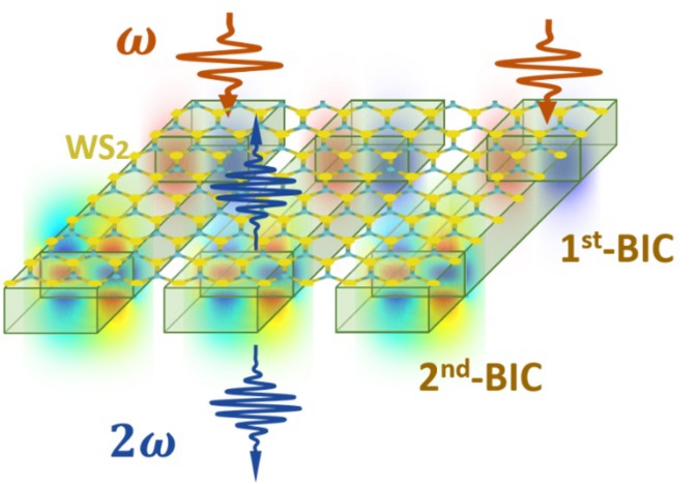A recent article from Opto-Electronic Advances discusses enhancing second harmonic production with TMDs monolayer through dual bound states in the continuum in a photonic grating slab.
 Schematic diagram of the dual BICs scheme for boosting SHG with monolayer WS2 on top of the photonic grating slab. Image Credit: OEA
Schematic diagram of the dual BICs scheme for boosting SHG with monolayer WS2 on top of the photonic grating slab. Image Credit: OEA
In nonlinear optical materials, two photons can be combined to produce a single photon with a twofold frequency. Second-harmonic generation (SHG), the name of this procedure, was initially identified in the 1960s, directly following the development of the laser.
Since the advent of SHG, several applications in cutting-edge technologies, including on-chip light sources, imaging, sensing, and communications have evolved.
For instance, the development of revolutionary all-optical NIR imaging technologies, such as night vision, is based on SHG-based imaging systems, which catch near-infrared (NIR) light and output light in the visible range.
Traditional bulk materials have been used to illustrate various nonlinear optical applications, but recently developed two-dimensional (2D) materials are opening up new possibilities. For instance, Transition Metal Dichalcogenides (TMDs) crystals display direct bandgap, intense luminescence, room-temperature stable excitions, and significant second-order nonlinearity when they are thinned down to be monolayers.
Monolayers of TMDs are an intriguing research platform for investigating novel linear and nonlinear optical phenomena and their associated applications due to their distinctive optical characteristics.
However, a single TMDs monolayer generates a weak SHG signal because of the atomic-scale interaction length with light. This severely impedes the creation of useful nonlinear meta devices made of 2D materials.
High-refractive-index dielectric nanoresonators have emerged as a viable platform for boosting SHG in recent years. Furthermore, it has been demonstrated that increasing the intensity of the light field within these dielectric resonators can be used to address the low SHG efficiency of 2D materials.
They have minimal optical losses at visible and NIR wavelengths compared to their plasmonic equivalents. The capacity of dielectric nanoresonators to show substantial light field confinement, also known as the bound state in the continuum (BIC), has been described as one of its distinguishing characteristics.
A potential method to improve SHG in 2D materials has been developed using the continuum-based BIC eigenfrequency.
A dual BICs scheme with the fundamental and second harmonic waves in resonance simultaneously has recently been proposed by a global team featuring Nottingham Trent University and the University of Electronic Science and Technology of China to improve the conversion efficiency of SHG from TMDs monolayer.
A thoroughly thought-out GaP grating slab has a pair of cavity modes, as seen in Figure 1. The dual-BICs resonance technique significantly amplifies the TMDs monolayer’s SHG signal when it is transferred onto the BICs slab.
In other words, excitation of the first BIC can significantly increase the electric field of the fundamental light, and stimulation of the second BIC at a harmonic wavelength will further increase the nonlinear emission.
The significant challenge in this study was matching the spatial modes of the fundamental and second-harmonic waves of the BIC-resonant wave within the TMD monolayer.
Researchers have demonstrated that a slight tilt in the fundamental wave’s incident angle can significantly enhance spatial mode matching within a TMDs monolayer, leading to an increase in SHG efficiency of four orders of magnitude compared to a monolayer made solely of TMDs.
Moreover, the researchers have shown that patterning the TMDs monolayer can enhance spatial mode matching by examining the 2D properties of the TMDs monolayer. This would further strengthen the SHG process of TMDs monolayer and increase SHG signal to seven orders of magnitude.
These findings provide new options for nonlinear optics with atomic thin 2D materials, including new types of light sources and all-optical night vision technologies based on frequency conversion, and give new ways to improve SHG in practical applications using TMDs monolayers.
Peilong Hong, Lei Xu, and Mohsen Rahmani’s research, titled “Dual bound states in the continuum enhanced second-harmonic generation with Transition Metal Dichalcogenides monolayer,” was recently published in Opto-Electronic Advances.
Journal Reference:
Hong, P., et al. (2022) Dual bound states in the continuum enhanced second harmonic generation with Transition Metal Dichalcogenides monolayer. Opto-Electronic Advances. doi:10.29026/oea.2022.200097